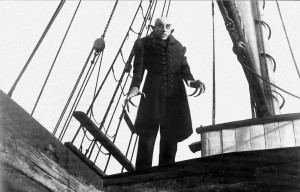My take: Max Schreck’s vampire carries the film and makes it worth watching for his spider-like fingers and dominant presence on screen.
I’m at the third movie listed in Studies in Terror: Nosferatu. I’ll admit, I’ve seen this German horror classic before, and I have always liked it. Not only is it a solid vampire movie, especially given its age, but it is also a study in copyright issues. The film follows Stoker’s oft-told tale of Dracula. The difference: director F W Murnau never got the rights from Stoker’s estate. As a result:
- We have Count Orlok and not Count Dracula
- The story does not take place in London, it’s set in Bremen, Germany
- The names are all different (if you are watching an old version of the film)
- Vampire bites do not create more vampires; they lead only to death
I don’t think these changes are necessarily a bad thing. Instead, they set the film apart from the book. The first time you watch it, it is similar enough to the book that you can follow it but the slight variations keep you on edge, unsure of where this particular version will take you.
One thing really popped out at me while watching this movie: somnambulism. When psuedo-Mina Harker’s character was sleepwalking, an intertitle referred to it as a “somnambulistic dream.” I couldn’t believe it. There was that word again that I had to look up while watching the Cabinet of Dr Caligari. I only noticed because I’m trying to “watch the book.” This seems to be a theme in 1920s horror, and I wonder if it will crop up in other films.
Sleepwalking fad aside, if you like vampire movies, this is the first great one. And anyone who professes a love for horror should watch this film at least once.
You can even find it on youtube now that it is in the public domain:

Leave a Reply